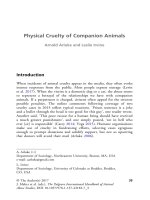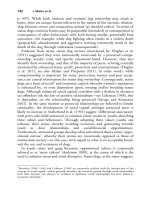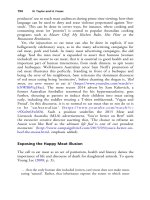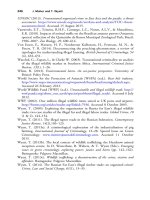The palgrave international handbook of a 299
Bạn đang xem bản rút gọn của tài liệu. Xem và tải ngay bản đầy đủ của tài liệu tại đây (38.23 KB, 1 trang )
296
P. Squires
which have given rise to particular forms of land management and the
creation of a ‘triumphant new cultural formation’—the Highland
Sporting Estate. These new elite recreational destinations, ‘formed the
centrepiece of the social calendar for the upper classes who would head
north on the new railways to shoot grouse, stalk deer and fish for salmon’
(Wightman 2004, p. 4). Now such estates are said to form a sports
shooting tourist economy that is claimed to bring substantial economic
benefits to Scotland as a whole. Grouse-shooting alone is said to earn the
Scottish economy £30 m while some even estimate that country sports as
a whole bring some £350 m annually to the nation’s account.
Unfortunately, the final destinations of much of this income are seldom
so clearly accounted for (McKenna 2013). For instance, Wightman and
Higgins show that, despite their homespun tartan veneer, sports estates
are, first and foremost, economic and business assets making predictable
use of off-shore tax-havens (Wightman and Higgins 2000). On the other
side of the coin, a report commissioned in 2012 by the Scottish
Government, the Scottish Land Reform Review Group, estimated that,
as one legacy of the Highland Clearances, today just 432 people owned
50 % of Scotland’s private rural land (LRRG 2014). Wightman argues
that ‘the development of hunting estates was merely the next stage in the
transition to a capitalist system of landholding, [and that] the emotions
that the Clearances had evoked were in many senses rekindled by the
spread of the hunting estates’ (Wightman 2004, p. 7).
The Land Reform Review Group went on to propose limits to individual
landholding and a system of licensing for shooting estates. Jim Hunter a
former member of the Review Group remarked that: ‘Scotland continues to
be stuck with the most concentrated, most inequitable, most unreformed and
most undemocratic land ownership system in the entire developed world’
(quoted in McKenna 2013). The Field magazine, true to its mission of
promoting the interests of the world of hunting and shooting classes, said
something similar, but put it rather differently: Scotland, it claimed, ‘is the
last place in Europe where a rich man can buy a large chunk of wilderness to
act out his dreams of owning a kingdom as well as enjoying a wide diversity
of sport’ (cited in Wightman et al. 2002, p. 64). Perhaps this is what it is
really all about: personal autonomy, dominion over nature and a power over
life and death.
The core dilemmas deriving from this inequitable distribution of land have
concerned the extent to which issues of public interest, bio-diversity and sustainability were being served by such concentrated patterns of land-ownership. The
Review Group Report catalogued a number of instances where the land









